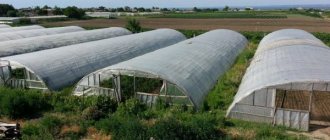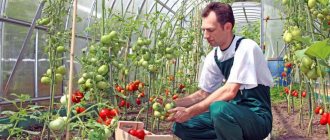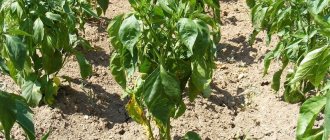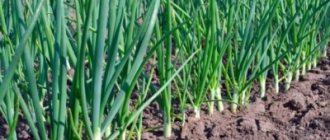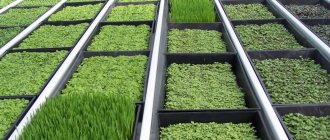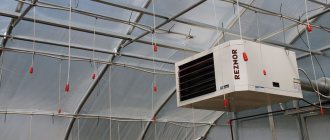Vegetables and berries grown in a greenhouse are in demand all year round. According to statistics, almost a fifth of all vegetables consumed in Russia are produced in greenhouses. The most profitable thing to grow in greenhouses is not fruits and vegetables, but greens: they are easy to care for, and you can harvest several harvests a year. It is also cost effective to grow flowers.
A greenhouse is a promising business if you approach it seriously and calculate the risks. Vegetables and herbs grown in the Russian Federation enjoy great confidence among buyers. It is difficult to make excess profits in such a business, but it can be considered as a source of small stable income, especially if you have your own plot.
Greenhouse farming: relevance and business features
The state supports the development of agriculture and helps farmers. You can get a plot of land at a reduced rate, a grant for the development of your farm and the opportunity to take out a loan on preferential terms. The main difficulty remains utility tariffs.
Production volumes in Russian greenhouses are growing every year due to the construction of new greenhouse facilities. But the consumer need for such products is not fully satisfied. The need is estimated at 3 million tons and grows by 10-15% every year, and no more than 600,000 tons are collected from open ground.
The greenhouse business is more suitable for residents of the southern regions of the country. Transportation to the north will be cheaper than maintaining the microclimate in a greenhouse in the northern regions. Payments for gas and electricity will eat up a significant share of income.
Greenhouse farming has its own specifics: a certain electricity quota is allocated to greenhouses. In such conditions it is difficult to maintain the greenhouse in proper condition.
Long-distance transportation is profitable only if logistics are fully established. But it’s not without reason that large agricultural complexes are trying to organize work in the far southern regions. There are four advantages:
- cheap labor;
- inexpensive land;
- long daylight hours;
- business subsidies.
If you decide to start a greenhouse, first of all, find out whether it is profitable to grow vegetables in your region and whether it is easy to arrange logistics. The second thing to do is decide what you will grow.
How profitable is it to grow flowers?
This direction of the greenhouse business is considered the most promising and profitable. Just look at the sale of flower bouquets by February 14 or March 8. It is estimated that the profitability of this area is approximately 70%. That is, in about six months you can get into the black. In addition to holidays, fresh flowers are constantly in demand in florist salons and specialty stores.
Tulips, daffodils, and chrysanthemums are suitable for greenhouse cultivation. You can also plant bush roses. With excellent care, you can cut about two hundred buds from 1 bush. One square of land will accommodate 3-4 rose seedlings. The profit is obvious.
Attention! The cost of caring for flowers is higher than in the case of vegetables or herbs. Decorative crops are very capricious.
Types of greens for growing in a greenhouse
Experts believe that flowers bring more income. Therefore, entrepreneurs invest the most money in growing roses or other flower plants.
In second place are greens: dill, parsley, onion. There are other types of greens - onions, basil, garlic, cilantro. Onions are the easiest to grow, but there may be difficulties with distribution channels. Experts call salad the most cost-effective type of greens.
It is better to start with several types of greens and gradually expand the list of crops grown. When choosing, consider how much area is needed to sow this crop, what its growing season is, growing conditions, hardiness, as well as price and demand.
Think through your sales channels in advance: both wholesale and retail sales of greens, industrial processing or delivery to catering establishments are possible.
The cost of fresh greens is very high and reaches several hundred rubles per kilogram, and growing them is much easier than cucumbers and tomatoes.
Which products to choose?
You can grow different vegetables - exotic or traditional for your region. The most popular options among local crops include:
- beets, carrots, potatoes;
- cucumbers, tomatoes, peppers;
- cabbage
You can read more about growing tomatoes in a greenhouse in our article.
Cabbage is the most unpretentious vegetable
These vegetables do not require special storage and cultivation conditions. Caring for them does not cause much trouble.
Important! The degree of exoticism of vegetables directly affects their cost. If a crop is not typical for a given area, care will have to be taken to create the appropriate conditions for it. This will require additional costs, and due to low demand, the problem of loss of presentation may arise.
When choosing products, you should not ignore customer requests. In the early stages of work, it is better to focus on vegetables that are in demand among consumers throughout the year.
Prices for cabbage seeds
cabbage seeds
Choosing land for a greenhouse
You will need a plot of land with an area of 50 square meters. meters (for one greenhouse). Most often, such businesses are opened on their own plots. If you do not own land, you can rent it.
You may be interested in: Stages of opening a hotel for animals
The land must be fertile. The proximity of the road is important, because you will have to deliver your products to customers yourself, and the availability of communications: water and electricity. It is advisable that the nearest city is no more than 30 km away.
Project preparation time
To determine not only the volume, but also the time of profit, it is necessary to make several calculations:
- preparation of the territory, construction of greenhouses and their connection to networks must be carried out in T-time (you can find out this figure if you take into account the number of workers, the type of greenhouse and its size);
- acquisition of equipment and its installation;
- purchasing and planting planting materials;
- Based on your work strategy, determine the timing of crop ripening;
- terms of sale of goods.
As a result, you will be able to determine the approximate time of profit. Please note: if your contract with the customer does not provide for immediate payment upon receipt, and you receive money based on the quantity of products sold, then the average period of damage to the crop must be added to the above formula.
You need to start your business by searching for wholesale buyers who will be ready to purchase your products: wholesale centers, stores, markets.
Greenhouse business from scratch: choosing technology
Today, three main technologies for growing vegetables in a greenhouse are widely used.
Hydroponics
- the most budget-friendly technology that allows you to forget about such concepts as unfavorable weather, cold or heat. This is a technology that makes it possible to almost completely forget about risks. The microclimate in a greenhouse depends not on the whims of Mother Nature, but on computers that calculate the entire growing system down to the smallest detail.
There are no problems with cultivation. Tomatoes or other vegetables are planted in containers with water, and they go through the entire growing season many times faster than under normal conditions - cheaply and without risks. But vegetables grown in this way have neither taste nor smell. And the consumer wants to eat tomatoes all year round that are similar to those that grandmothers sell at the market.
Cultivating cucumbers and tomatoes hydroponically is unprofitable, but onions and dill are quite possible. Greens grown this way do not lose their taste.
Intermediate technologies
are based on adding soil to the solution supplied to the plants. Growing this way costs a little more, but the vegetables are much more like real ones.
Mobile bed
- one of the most expensive technologies for growing vegetables. But the money invested pays off, since the taste of the products is very similar to those grown in natural conditions.
Robotic cucumber picker
Above we talked about how science makes the hard work of farmers responsible for the tomatoes on our table easier. Well, what about cucumbers? A tomato definitely needs a cucumber. It turns out that science can make life easier for cucumber farmers too.
We will not be talking about genetics, but about innocent robotics. A cucumber picking robot does this hard work instead of a human. The robot was invented in Germany. It has two gripping arms and does not harm the beds. In general, it drives carefully, and not like a bull in a china shop.
This is a whole experiment and it is called CATCH. It is sponsored by the EU, and Germany is only a pilot site. Soon robotic pickers will work instead of people during the harvest. This is the main goal of the European Union.
Why and why did the European Union need this - to replace human harvesters with robots? It is no secret that guest workers – migrant workers – come everywhere during the season to harvest the harvest (terribly hard, low-skilled and low-paid work).
Some of them travel almost under a “black flag” and are not paid anything at all for their work. And what terrible conditions they live in. In general, the problem of harvesting has always been a difficult problem. Just have time to collect, otherwise it will rain and everything will rot! It is not surprising that peasant women gave birth in the field, swaddled the baby and immediately began to work again. Strada! And remember the Soviet autumn “potato harvesting trips”, where schoolchildren, students and even enterprise employees and scientists from research institutes were sent...
So, using cheap, often illegal, almost slave labor is unethical and unsustainable. It is especially unwise to create a socially explosive environment by opening borders to people who have never seen anything good in their lives. They will get a little rich from the harvest. They will create more problems – both for themselves and for others.
Greenhouse as a business: paperwork
If you consider the greenhouse as a subsidiary farm, then you will not need any special documents. A certificate stating that you are the owner of the land on which the greenhouse is located and products are grown for sale is sufficient.
But when it comes to serious business, you will need to register an individual entrepreneur or a peasant farm. When registering the latter, certain benefits are provided (the tax on peasant farms is only 6%).
OKVED code 01.13.9 - Growing vegetables not included in other groups. You also need permission from the fire service and Rospotrebnadzor.
To register you will need:
- a copy of the passport of the head of the peasant farm;
- statement;
- a receipt confirming payment of the state duty (800 rubles);
- copies of passports of other members of the household, if available (to confirm relationship).
At the same time, you need to submit documents on the transition to a simplified tax regime.
All products must comply with GOST requirements. For each type of greens and vegetables there is its own GOST.
To make it easier for you to work with retail outlets and sell your products, it is advisable to obtain an environmental certificate. Certification of greens is controlled by the Technical Regulations of the Customs Union “On Food Safety 021/2011”. There are requirements for packaging and labeling of products. Greens are tested for bacteria and parasites, pesticides, nitrates and toxic substances.
It doesn’t make sense to do this for one greenhouse, but if you are planning to start a large farm, certification will help you establish sales. For this purpose, it is necessary to prepare the following documents:
- application;
- technical documentation,
- Product specifications;
- GOST certificate of conformity.
The certification procedure may take a long time. But a certified product is valued much more, so it’s worth going through it. This will require 50-60 thousand rubles.
Basic costs
A winter greenhouse as a business requires significant initial investment. These include:
- Purchase or lease of land. The price depends on the distance. It is worth considering that a farm located far away increases transportation costs.
- Construction and equipment of a greenhouse. The most expensive option is a fully automated structure with a climate control system, drip irrigation, self-ventilation, fogging and shading.
- Purchase of planting material. The cheapest option is to buy seeds. Grown seedlings and cuttings for flower rootstocks are more expensive. In the future, you can allocate an area in the greenhouse for the constant cultivation of seedlings for yourself and for sale.
- Registration of a farm or individual entrepreneur. Necessary for entrepreneurs planning active work with retail and attracting employees. A small greenhouse on its own plot does not require registration, but it limits the farmer’s ability to find buyers for his products.
In addition to one-time expenses, the farmer also faces monthly expenses . These include:
- expenses for heating, lighting and plumbing;
- purchase of fertilizers;
- fare;
- employee salaries.
Materials and equipment
When building a greenhouse, it is important to decide whether you will use glass or polyethylene for covering.
Glass:
- expensive;
- durable;
- allows a large amount of sunlight to pass through, and you need to purchase material whose thickness is at least 6 mm;
Polyethylene:
- is cheap;
- short-lived;
- does not transmit sunlight as well as glass.
Therefore, polyethylene is more suitable for the southern regions, and glass for the northern regions. However, there are alternative options: polycarbonate and acrylic. They eliminate the disadvantages of polyethylene, while being cheaper than glass.
You will need:
- greenhouse frame (from 40,000 rubles per piece),
- glass, polyethylene or polycarbonate (from 6,000 rubles),
- irrigation system, tank, pipe, pump (from 10,000 rubles),
- lighting system, cable, lamps (from 15,000 rubles),
- ventilation system (from 15,000 rubles),
- garden tools (from 5,000 rubles).
You may be interested in: Business of breeding and selling purebred dogs
Probability of risk
In the process of growing products indoors, you may find yourself at risk. When doing business, certain circumstances may arise that result in financial damage:
- Changes in energy prices. If tariffs rise and vegetable cultivation continues into the winter, income cannot always cover the cost of heating the greenhouse.
- Market dynamics. It needs to be taken into account - if cabbage is harvested well this year, this does not mean that next year you can earn a lot of money from selling it. Competitors can reduce prices or diversify their range at any time.
- Development of diseases, pests. If you do not regularly monitor the condition of the plants and do not take timely measures to protect them, 2-3 days are enough to lose the entire harvest.
Aphids are farmers' worst enemy
Important! If there is a possibility of risk, do not be afraid of it and stop trying to organize your business. Trial and error is also a valuable experience on the path to success.
Video – Greenhouse business of the Hertz family
Taking into account the risks and likely changes, the business plan will be more in line with reality.
How much money do you need for a greenhouse business?
Let's make approximate calculations to understand how much money you need to invest in the greenhouse business. In the example, we will look at the rental option.
| Expense item | Cost, rub.) |
| Rent | 20 000 |
| Materials and equipment | 100 000 |
| Inventory, seedlings, seeds | 30 000 |
| Documentation and certification | 70 000 |
You also need to set aside a certain amount for unforeseen expenses - 50,000.
You can perform the duties of the director of the enterprise yourself. You can outsource an accountant. The minimum investment in the business will be about 220,000 rubles.
If you own the site - 200,000 rubles, and minus certification costs - 150,000 rubles.
In addition, there will be monthly expenses - 20,000 for rent and about 30,000 for workers' salaries (at least 2 of them will be needed).
Financial plan
Initial Investment
To start a business you will need capital investment according to the table below:
| Expenditure | Amount, rub. |
| Registration | 800 |
| Polycarbonate greenhouse | 150000 |
| Heating and lighting installation | 20000 |
| Delivery and installation of the greenhouse | 10000 |
| Purchase of gardening equipment and tools | 10000 |
| Soil, humus, black soil | 5000 |
| Pest Control | 2000 |
| TOTAL: | 197800 |
Current expenses
The following expenses are planned monthly:
| Expenditure | price, rub. |
| Public utilities | 12000 |
| Wage | 86000 |
| Contributions to funds | 26660 |
| Tax (6% of income) | 16163 |
| Banking services | 2500 |
| 7000 | |
| TOTAL: | 150323 |
Income from product sales
Planned income at the beginning of activity will be:
| Name of product | Number of sales per month in kg | Selling price per 1 kg | Income, rub. |
| cucumbers | 1150 | 95 | 109250 |
| Tomatoes | 950 | 110 | 104500 |
| Green onions | 250 | 79 | 19750 |
| Dill | 200 | 70 | 14000 |
| Parsley | 130 | 70 | 9100 |
| Salad | 142 | 90 | 12780 |
| TOTAL: | 269380 |
Profit
With the declared income, the profit will be 119,057 rubles.
Marketing and sales channels
Most often, the target audience is wholesale buyers (vegetable warehouses or grocery/vegetable stores).
Therefore, marketing is usually based on promotion among distributors, rather than end consumers. Your goal is to develop a base of wholesale buyers and establish long-term cooperation with them, because greens are a perishable product and need to be sold quickly.
What should be done:
- analyze the market and competitors,
— find wholesale buyers and offer them more favorable conditions than competitors (in terms of prices, delivery times and conditions, etc.).
- send out commercial offers.
Main buyers:
- grocery chains,
- retail supermarkets,
- vegetable warehouses;
- farm shops;
- catering: cafes and restaurants.
You need to establish sales channels at least a month before the first harvest.
Berries
The most promising berry for growing in greenhouse conditions is the remontant strawberry. Rest assured - strawberries in a greenhouse all year round as a business will fully pay for themselves in just one season. Strawberries ripen in the beds for a maximum of a month, from late May to mid-June, after which the market is empty. People are happy to buy fresh strawberries in summer, autumn, and even winter, so you definitely won’t go broke. The main thing is to organize the process correctly and achieve its uniform maturation.
